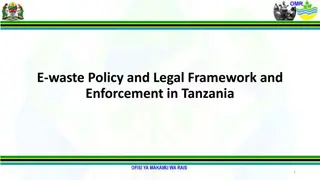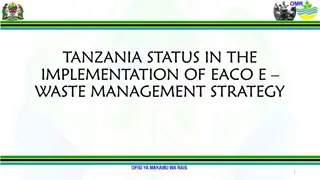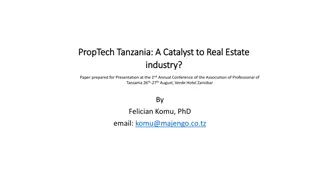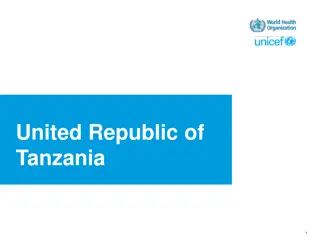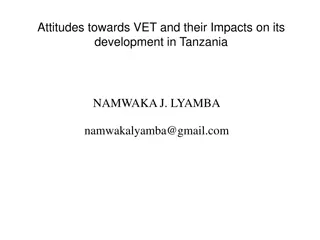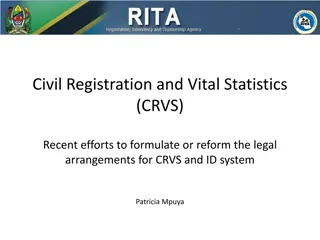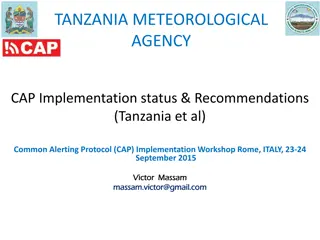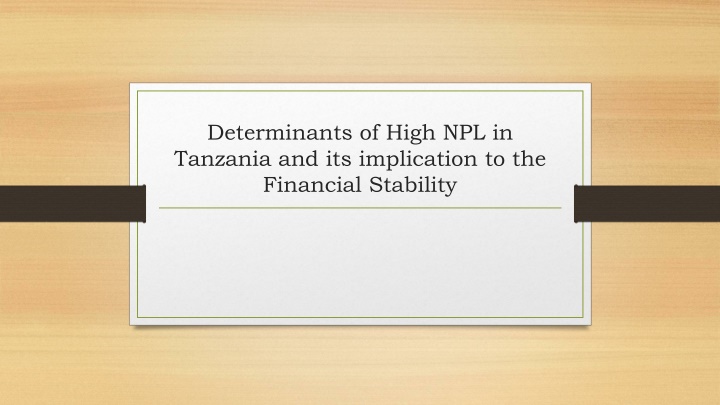
High NPL Determinants in Tanzania for Financial Stability
Explore the factors contributing to high Non-Performing Loans (NPLs) in Tanzania and their implications on financial stability. Discover the impact of Covid-19, key sectors affected, causes of high NPLs, and efforts to reduce NPL ratios. Gain insights into credit underwriting weaknesses, business challenges, and strategies to mitigate NPL risks in the Tanzanian banking sector.
Download Presentation

Please find below an Image/Link to download the presentation.
The content on the website is provided AS IS for your information and personal use only. It may not be sold, licensed, or shared on other websites without obtaining consent from the author. If you encounter any issues during the download, it is possible that the publisher has removed the file from their server.
You are allowed to download the files provided on this website for personal or commercial use, subject to the condition that they are used lawfully. All files are the property of their respective owners.
The content on the website is provided AS IS for your information and personal use only. It may not be sold, licensed, or shared on other websites without obtaining consent from the author.
E N D
Presentation Transcript
Determinants of High NPL in Tanzania and its implication to the Financial Stability
NPLs Profile in Tanzania NPLs ratio in Tanzania has remained above desired level of 5% for quite a while; Recently, the NPLs has declined to pre-Covid-19 pandemic levels of around 9%; An improvement is attributed to efforts taken by the central bank to reduce the NPLs;
NPLs and Covid-19 pandemic Initially, NPLs rose in mid-2020; Following measures taken to contain the impact of Covid-19 in the banking sector, The NPL ratio improved during the quarter ending March 2021, reaching around 9.00 percent same as before the onset of COVID-19 pandemic; It is still above the desired level of below 5.00 percent; Measures taken by the Bank provided relief in loan repayment through loan restructuring, which abated NPL
Analysis of NPLs Analysis of contribution to NPLs revealed the following sectors with significant contributions: Trading: 22 percent Personal Loans: 11 percent Agriculture: 11 percent Activities with highest level of NPLs: Warehousing and storage: 42 percent Tourism: 36 percent Mining and quarrying: 27 percent Fishing: 23 percent Real estate: 20 percent
Causes of High NPLs Key factors contributing to high NPLs include:- Weaknesses in credit underwriting and monitoring, Diversion of funds by clients to establish new ventures due to difficulties in their existing business, Decreased in business cash flows due to COVID -19 pandemic, The slowdown in business: adversely impacted trading and business transactions: the tourism and hotel industry Decline in global demand affecting firms involving in export of goods and services; Delayed completion of funded projects particularly of construction nature, Low occupancy rate for the completed real estate s projects and hotels, Difficulties in disposal of pledged collaterals due to fall in prices and prolonged court procedures and processes, Higher interest rates, penalties and other transaction fees have increased the cost of funding to firms leading to failure to service their loans. Due to high borrowing costs, loan repayments become highly sensitive to business conditions, a small deterioration increases likelihood of non-payment
Measures to Contain NPLs The Bank took various regulatory measures to address the high level of NPLs: - Restricting payment of bonuses and dividends by banks with NPLs ratio above the desired level of 5 percent; Enhanced monitoring by directing banks to implement and report NPLs reduction strategies on quarterly basis; Direct banks to improve credit-underwriting processes by using credit reference reports in loan application assessment and granting process; enhance loan recovery efforts; and adhere to the Tanzania Banker s Association Code of Conduct to, among others, enhance staff integrity.
Implications to Financial Stability The slowdown in economic activity will continue to negatively affect the financial condition of households and businesses, many of whom will face a significant loss of income:- The loss of income will mean that some borrowers will experience difficulty in repaying their loans, with an adverse knock on effect on the financial performance of banking institutions. Credit risk from declining loan quality will increase risk to financial stability as weak economic activities lead to a rise in loan losses affecting asset quality and banks balance sheet. The economic impact of COVID-19 has affected the liquidity position of some banks as borrower s ability to pay declined leading to deterioration of liquidity condition of the sector, The impact was muted due to measures taken by the central bank
Recommendations To tame a growing trend of NPLs and therefore improve Financial Stability Focus on sectors specific situation- hotels and tourism, trading may need different policy interventions; Loan restructuring to prevent insolvency of borrowers and mitigate further impairments of asset quality, Institute measures to improve credit underwriting process and loan recovery efforts, Use of credit reference system to reduce exposure to credit risks, Enhancement of staff integrity through peer pressure and industry code of conduct, Linking payment of dividends and bonuses to asset quality (to incentivize banks to contain NPLs and improve efficiency) Institute short to medium term rescue package for areas that have been highly affected by pandemic to minimize corporate insolvencies, Increase liquidity in the economy including reduction of reserve requirement, discount rate and haircuts to Government securities



